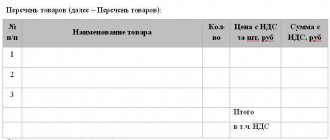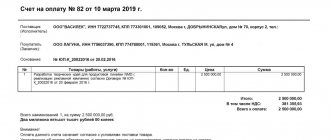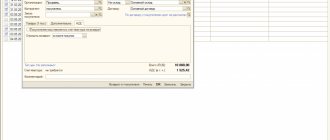Today, an invoice is a common document that serves as the basis for agreeing with management on payment by bank transfer/cash.
It indicates the seller or performer of a certain work (as a legal entity or individual entrepreneur), current account number and bank details, address, list of goods or services that are subject to payment. Quantity, price and, if applicable, VAT must be indicated. The date and number are needed only for internal document flow. It can be sent by fax, by mail, sent by courier, delivered in person, or electronically.
In what situations is an invoice issued?
Before the start of any cooperation, counterparties, as a rule, enter into agreements that stipulate payment terms, amounts and other terms of transactions.
In addition, our legislation does not require transactions without contracts. If the terms of the contract do not stipulate that the seller must issue an invoice for payment, there is no need to do this. In this case, the buyer must pay for the service or product only on the basis of an agreement.
But there are situations when you can’t do without an account. In the event that the terms of the contract do not specify the amount that the buyer must transfer, the seller must issue an invoice without fail.
This may be the case, for example, when paying for communication services: in contracts of this kind, the amount, as a rule, is not specified in advance. An invoice is issued when an organization carries out transactions subject to VAT, and in other cases established by law.
Such an invoice should be issued to the customer (or buyer):
- an organization exempt from VAT (Article 145 of the Tax Code of the Russian Federation);
- an organization that sells goods or services under an agency agreement on its own behalf, subject to the application of the general taxation system, clause 1 of Art. 169 Tax Code of the Russian Federation;
- an organization that has received an advance/partial payment towards the upcoming sale of goods from the customer (Article 168 of the Tax Code of the Russian Federation).
Primary documentation in accounting list of documents 2020
Transactions vary significantly from company to company. Despite this, there is a list of primary documentation that is required in accounting:
- Agreement.
- An invoice for payment.
- Payment documents: cash receipts, strict reporting forms.
- Packing list.
- Certificate of work performed or services provided.
- Invoice.
This list of transaction documents is not exhaustive; it can expand depending on the types of transactions and accounting features in the organization.
Why do you need an account?
Apart from issuing an invoice, there is no other way to speed up settlement between the parties . The invoice acts as a preliminary agreement, when the seller sets prices for his goods, and the buyer makes payment on its basis (without the actual existence of an agreement), the remaining documents are drawn up upon receipt of the goods. In this case, the invoice is usually issued in one copy.
In the financial industry, issuing an invoice is considered a serious business document. It is used mainly by legal entities and individual entrepreneurs who pay VAT.
Such an invoice may be issued by the seller (or performer) after the sale of goods or services. It is used to confirm payment of VAT and excise duty. In addition, it can inform about the country of origin of the goods and contains information about the customs declaration number (if the goods are imported). It is issued in a strictly established form and is considered the basis for deducting VAT amounts from the buyer. Issued in two copies.
How to issue an invoice correctly
Given the fact that the invoice in some cases compensates for other documents, it must be filled out correctly, for which any office application is ideal. In the center of the first line, the word “ACCOUNT” is written in capital letters; below is the number of the agreement and the date of its conclusion, full name, company name and bank details of the parties. Next, a table is filled in with data on the name of the product/service, unit of measurement, total quantity of product or volume of work, with each product or service described in a separate line. At the end of the table, the total amount and the VAT amount are indicated, and if the company is not a VAT payer, this fact is also recorded.
Read more: Where to go to privatize a land plot
Under the table, the words indicate the total amount to be paid, but in words, in rubles, kopecks, or other currency. The document is signed by the director of the LLC and the accountant (if this position is provided for in the staffing table). The original invoice is given in person, delivered by courier or sent by mail, a copy of the document can be sent by fax or email, and this is also a sufficient basis for payment.
Can I issue an invoice from an individual?
Since individuals who are not registered as individual entrepreneurs do not pay VAT, and an invoice can only be issued by an organization or individual entrepreneur with VAT, this function is not directly available to them .
Any serious company will not pay an invoice issued by an individual, exposing itself to taxes. Or you will have to register as an individual entrepreneur/closed joint stock company/LLC in order to be able to issue invoices, or draw up an agreement with an organization for the provision of a certain type of service, and it makes payment as an individual for the work performed. So, from a legal point of view, an individual and invoicing are incompatible concepts.
Information on how to obtain a copy of an individual’s TIN via the Internet is contained in this article. If you are wondering whether notification of the opening of a current account to the tax office or other authorities is required, find out about it here.
Invoice for payment from an individual entrepreneur or LLC
Today there is no form approving the type of account or suggesting its standard . It is not even considered an accounting document. An invoice is issued and issued for payment electronically or in paper form. Be sure to indicate the following:
- details of an individual entrepreneur or legal entity (identification code, name of the organization, its legal form and legal address);
- details of the servicing bank (name, address, current and correspondent accounts, BIC);
- codes (OKPO, OKONH).
Blank form and example of filling out an invoice for payment
After the individual entrepreneur has indicated his and the buyer’s details, the invoice number and the date of its formation are entered and the presence or absence of VAT is indicated. At the end of the individual entrepreneur’s document, you must indicate your last name, initials and sign. It is not necessary to put a stamp.
Most often, an invoice is created in a standard office program, Excel or Word: there you need to create a template into which data will be entered in the future.
It’s even better to use a special program that generates invoices. In addition, it will automatically keep records of all completed transactions, significantly simplifying accounting reporting. It will also allow you to track the payment of bills, eliminating the occurrence of errors, for example, transferring money to another account.
The following video shows issuing an invoice in the 1C 8.2 program:
We issue invoices in English
An invoice in English - invoice - is often used in Russia without translation. This document, first of all, must contain the word invoice (in Russian and English).
According to the recommendations of experts, any invoice issued in English must include the following information:
- outgoing and incoming own number;
- name, contact details of the seller;
- information and contact details of the buyer or customer;
- discharge date;
- company and tax information;
- date of dispatch/delivery/purchase/services rendered;
- order number or other number by which the customer can track the progress of delivery;
- total amount;
- payment terms;
- and other information, for example, special conditions, information about taxes, penalties for late delivery, late payment or refunds in case of damage to the order.
Since when issuing an invoice in English, as a rule, we are talking about cooperation with a foreign partner, and the laws in his country may differ from ours, it is important to describe everything in detail in the invoices. The data specified in contracts and invoices must be identical to the information in the delivery notes.
Possible errors when drawing up a document
If we analyze the problems that arise when preparing invoices, we can identify the following common mistakes:
- Lack of decoding of signatures of authorized persons (in electronic invoices such an error is eliminated: an electronic signature is placed on the document, which already contains information about the signatory).
- Violation of the five-day deadline for issuing an invoice - in this case, the problem is the different understanding of the terms “date of preparation” of the invoice and “date of issue”. In paragraph 3 of Art. 168 of the Tax Code of the Russian Federation, these concepts are not deciphered; it simply states that an invoice must be issued no later than 5 days from the date of shipment of goods. In addition, the details of the standard invoice form provide only one date, which is both the date of preparation and the date of issue.
- The invoice was not received in the tax period for which VAT was claimed for deduction (the Ministry of Finance recommends declaring the deduction in the same tax period in which the invoice was received). To eliminate this problem, organizations store envelopes, receipts, and keep logs of incoming mail.
- The seller's and buyer's copies of the invoice have different dates; as a rule, this is due to corrections (different copies of the same invoice are not evidence of the transaction).
- The presence of the signatures of the chief accountant and the manager on the invoice (according to the tax authorities, we are talking about using a facsimile signature, and on the basis of this you may be denied a deduction).
- Errors in the preparation of the invoice header (the name of the seller or buyer, their tax identification number or checkpoint, addresses, etc. are incorrectly indicated).
When an error is detected in the invoice, it is corrected in accordance with the established procedure (clause 29 of the Rules). If an invoice is corrected, the incorrect indicators are crossed out and the correct ones are entered, then the date of the corrections is indicated. Changes are certified by the signature of the manager and the seal of the enterprise. Please note that only the organization that issued this document can make corrections to the invoice.
Enter the site
RSS Print
Category : Taxation Replies : 276
You can add a topic to your favorites list and subscribe to email notifications.
« First ← Prev. ... ... Next. → Last (28) »
| SL [email hidden] Belarus, Vitebsk Wrote 348 messages Write a private message Reputation: | #141[830432] July 5, 2021, 10:18 |
EOV wrote:
Good afternoon. HELP. The portal does not accept ESCHF, it requires UNP. I am posting to an individual, what should I write in the UNP column?
1. Buyer’s UNP is an optional detail. Try to check - maybe the seller’s or the shipper’s UNP requires 2. Why do you issue an ESCHF to an individual at the beginning of the month? Is selling to an individual a one-time operation?
I want to draw the moderator's attention to this message because:Notification is being sent...
| EOV [email hidden] Wrote 35 messages Write a private message Reputation: | #142[830433] July 5, 2021, 10:22 |
SL wrote:
EOV wrote:
Good afternoon. HELP. The portal does not accept ESCHF, it requires UNP. I am posting to an individual, what should I write in the UNP column?
1. Buyer’s UNP is an optional detail. Try to check - maybe the seller’s or the shipper’s UNP requires 2. Why do you issue an ESCHF to an individual at the beginning of the month? Is selling to an individual a one-time operation? For each delivery (legal entity, individual) we issue a TTN, a general accountant. requires that the ESHF be set on the next day after the operation.
I want to draw the moderator's attention to this message because:Notification is being sent...
| Natalia [email protected] Belarus, Baranovichi Wrote 1937 messages Write a private message Reputation: 191 | #143[830442] July 5, 2021, 10:55 |
EOV wrote:
main account requires that the ESHF be set on the next day after the operation.
This is for legal entities! For individuals - 1 ESCHF at the end of the month/until the 5th of the next month.
I want to draw the moderator's attention to this message because:Notification is being sent...
| EOV [email hidden] Wrote 35 messages Write a private message Reputation: | #144[830443] July 5, 2021, 10:56 |
SL wrote:
EOV wrote:
Good afternoon. HELP. The portal does not accept ESCHF, it requires UNP. I am posting to an individual, what should I write in the UNP column?
1. Buyer’s UNP is an optional detail. Try to check - maybe the seller’s or the shipper’s UNP requires 2. Why do you issue an ESCHF to an individual at the beginning of the month? Is selling to an individual a one-time operation? The portal requires the recipient's UNP. Does not allow ESHF to pass through.
I want to draw the moderator's attention to this message because:Notification is being sent...
| Natalia [email protected] Belarus, Baranovichi Wrote 1937 messages Write a private message Reputation: 191 | #145[830449] July 5, 2021, 11:05 |
Quote:
DECISION OF THE MINISTRY OF TAXES AND DUTIES OF THE REPUBLIC OF BELARUS April 25, 2021 N 15 ON ESTABLISHING THE FORM OF AN ELECTRONIC INVOICE AND APPROVING INSTRUCTIONS ON THE PROCEDURE FOR CREATION (INCLUDING FILLING OUT), ISSUANCE (DIRECTION), PO RECEIVING, SIGNING AND STORING AN ELECTRONIC INVOICE - INVOICES 39. When selling objects to individuals for which the seller, based on the results of the reporting period, in accordance with part two of paragraph 8 of Article 106-1 of the Tax Code of the Republic of Belarus, creates one final ESFF, the seller in the ESFF indicates: in line 3 “Date of transaction” - the date of the business transaction, which corresponds to the last day of the corresponding reporting period;
in line 4 “ESChF type” - ESChF type “Initial”; in line 6 “Supplier status” - supplier status “Seller”; in line 15 “Recipient status (under agreement/contract)” - recipient status “Buyer”; in column 7 of section 6 “Data on goods (works, services), property rights” - the cost of the entire quantity (volume) of supplied objects excluding VAT; in column 9 of section 6 “Data on goods (works, services), property rights” - the VAT rates at which the corresponding objects are taxed; in column 10 of section 6 “Data on goods (work, services), property rights” - the amount of VAT calculated by the seller; in column 11 of section 6 “Data on goods (work, services), property rights” - the cost of the entire quantity (volume) of objects sold under the ESCHF, including VAT. Lines 16 - 30 and columns 3.1, 3.2, 4, 5, 6, 8 of section 6 “Data on goods (work, services), property rights” of the ESChF are not filled out.
The remaining lines and columns of the ESChF are filled out depending on the need and the specifics of their completion established in Chapter 3 of these Instructions.
Show the chief accountant - let him figure it out if she can't stand it
I want to draw the moderator's attention to this message because:Notification is being sent...
| EOV [email hidden] Wrote 35 messages Write a private message Reputation: | #146[830455] July 5, 2021, 11:25 |
Natalya wrote:
Scroll: Individuals
Quote:
DECISION OF THE MINISTRY OF TAXES AND FEES OF THE REPUBLIC OF BELARUS April 25, 2021 N 15 ON ESTABLISHING THE FORM OF AN ELECTRONIC INVOICE AND APPROVING INSTRUCTIONS ON THE PROCEDURE FOR CREATION (INCLUDING FILLING OUT), ISSUANCE (DIRECTION), RECEIPT, SIGNING AND STORING AN ELECTRONIC INVOICE 39 When selling to individuals objects for which the seller, based on the results of the reporting period, in accordance with part two of paragraph 8 of Article 106-1 of the Tax Code of the Republic of Belarus, creates one final ESFF, the seller in the ESFF indicates: in line 3 “Date of transaction” - the date of completion a business transaction that corresponds to the last day of the corresponding reporting period;
in line 4 “ESChF type” - ESChF type “Initial”; in line 6 “Supplier status” - supplier status “Seller”; in line 15 “Recipient status (under agreement/contract)” - recipient status “Buyer”; in column 7 of section 6 “Data on goods (works, services), property rights” - the cost of the entire quantity (volume) of supplied objects excluding VAT; in column 9 of section 6 “Data on goods (works, services), property rights” - the VAT rates at which the corresponding objects are taxed; in column 10 of section 6 “Data on goods (work, services), property rights” - the amount of VAT calculated by the seller; in column 11 of section 6 “Data on goods (work, services), property rights” - the cost of the entire quantity (volume) of objects sold under the ESCHF, including VAT. Lines 16 - 30 and columns 3.1, 3.2, 4, 5, 6, 8 of section 6 “Data on goods (work, services), property rights” of the ESChF are not filled out.
The remaining lines and columns of the ESChF are filled out depending on the need and the specifics of their completion established in Chapter 3 of these Instructions.
Show it to the chief accountant - let him figure it out if she can’t stand it. Thank you.
I want to draw the moderator's attention to this message because:Notification is being sent...
| leon_1308 [email hidden] Wrote 665 messages Write a private message Reputation: | #147[835006] July 28, 2021, 12:15 |
Notification is being sent...
| Marichelle [email hidden] RB, Gomel Wrote 185 messages Write a private message Reputation: | #148[835015] July 28, 2021, 12:36 |
leon_1308 wrote:
Good afternoon! Transport expedition on the simplified tax system without VAT. Need to deal with electronic invoices?
personally, no, but if you put a car with VAT, your customer (client) needs it, and if you re-invoke it (this should be the case), then YES
I want to draw the moderator's attention to this message because:Notification is being sent...
| leon_1308 [email hidden] Wrote 665 messages Write a private message Reputation: | #149[835024] July 28, 2021, 12:50 |
Marishel wrote:
leon_1308 wrote:
Good afternoon! Transport expedition on the simplified tax system without VAT. Need to deal with electronic invoices?
Personally, you don’t, but if you put a car with VAT, your customer (client) needs it, and if you re-invoke it (that’s how it should be), then YES I don’t understand. If I issue an invoice to the customer with VAT (without working with VAT), then do I also fill out the ESCHF?
I want to draw the moderator's attention to this message because:Notification is being sent...
| Marichelle [email hidden] RB, Gomel Wrote 185 messages Write a private message Reputation: | #150[835188] July 28, 2021, 5:11 pm |
leon_1308 wrote:
Marishel wrote:
leon_1308 wrote:
Good afternoon! Transport expedition on the simplified tax system without VAT. Need to deal with electronic invoices?
Personally, you don’t, but if you put a car with VAT, your customer (client) needs it, and if you re-invoke it (that’s how it should be), then YES I don’t understand. If I issue an invoice to the customer with VAT (without working with VAT), then do I also fill out the ESCHF? Yes. Your car can be with or without VAT. 99% of expediters/auditors on taxation system without VAT do not re-invoice VAT to the customer. if you decide to act honestly, you are obliged to do ESF
I want to draw the moderator's attention to this message because:Notification is being sent...
« First ← Prev. ... ... Next. → Last (28) »
In order to reply to this topic, you must log in or register.










